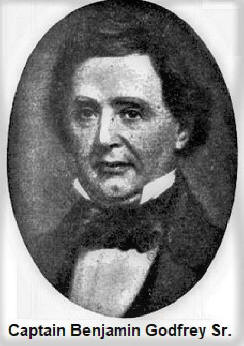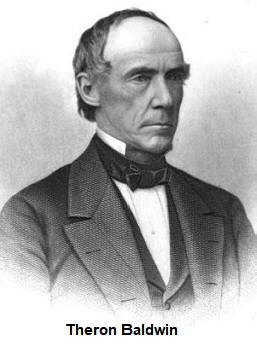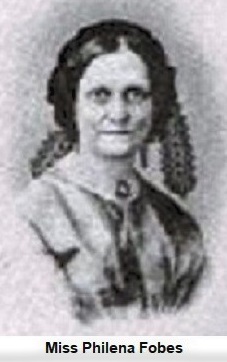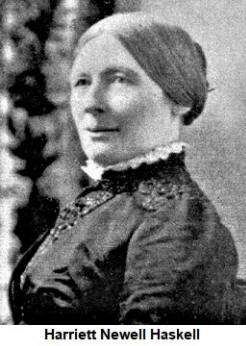Monticello Ladies Seminary, Godfrey
Monticello Ladies Seminary Newspaper Articles
The Founding of the Monticello Female
Seminary
Captain
Benjamin Godfrey, who had six daughters and two sons with his
first wife, Harriet Cooper Godfrey, believed in the Christian
education of young women. He conceived the idea of founding a
seminary, and in 1836,
 The stone building was four stories high, 110 x 44’. The two upper
stories contained 40 rooms, each designed to accommodate two young
ladies. Each dorm room was furnished with a double bedstead,
mattress, table, and chairs. All additional furniture had to be
provided by the occupants. The second story was divided into school,
recitation, and family rooms. The first floor contained the kitchen,
dining hall, and chapel. A woman was hired to superintend the dorm
rooms, and each student had to be at least 14 years of age. The
pupils were required to clean their own rooms, do their own washing
and ironing, and assist in setting and clearing the tables and
keeping order in the building. The family of the principal and
teachers resided in the seminary building also.
The stone building was four stories high, 110 x 44’. The two upper
stories contained 40 rooms, each designed to accommodate two young
ladies. Each dorm room was furnished with a double bedstead,
mattress, table, and chairs. All additional furniture had to be
provided by the occupants. The second story was divided into school,
recitation, and family rooms. The first floor contained the kitchen,
dining hall, and chapel. A woman was hired to superintend the dorm
rooms, and each student had to be at least 14 years of age. The
pupils were required to clean their own rooms, do their own washing
and ironing, and assist in setting and clearing the tables and
keeping order in the building. The family of the principal and
teachers resided in the seminary building also.
The school year was divided by the summer term (18 weeks, succeeded
by a vacation of 8 weeks) and winter term (22 weeks, followed by a
vacation of 4 weeks). The tuition, payable in advance, was $9.00
($272.08 in 2022) for the summer term, and $11.00 ($332.54 in 2022)
for the winter term. The boarding bill was separate, and was $1 for
each week of that term.
The course of study included the Bible, Colburn’s First Lessons,
Adams’ New Arithmetic, Day’s Algebra, Smith’s and Murray’s Grammar,
Malto Brun’s School Geography, Goodrich’s History of the United
States, Worcester’s Elements of History, Grimshaw’s France, and
Goldsmith’s England, Greece, and Room, Phelps’ and Eaton’s Botany,
Watts on the Mind, Newman’s and Whateley’s Rhetoric, Hayward’s and
Combe’s Human Physiology, Playfair’s Euclid, Olmsted’s Natural
Philosophy, Comstock’s Chemistry, Wilkins’ Astronomy, and Burritt’s
Geography of the Heavens, Abercrombie’s Intellectual Philosophy,
Smellic’s Philosophy of Natural History, Mather’s Geology, Marsh’s
Ecclesiastical History, Hedge’s Logic, Paley’s Natural Theology,
Wayland’s Moral Philosophy, Butler’s Analogy, and Alexander’s
Evidences of Christianity. The books could be purchased at George
Holton’s Bookstore in Alton. The first teachers were Miss Mary Cune
and Miss Philena Fobes, who both had experience in distinguished
female seminaries. Others were added as needed. Christian services
were held by the seminary’s first principal, Rev. Theron Baldwin.
Rev. Theron Baldwin – Monticello’s
First Principal
Rev. Theron
Baldwin was an 1827 graduate of Yale College. He entered the
Theological Department, where he played a leading role among a small

Monticello Female Seminary Opens in
1838
The Monticello Female Seminary was officially opened on April 11,
1838, with 57 students. The first graduation was held August 14,
1838. By the second year, the number of students rose to 104. The
catalog of 1840 advertised tuition for the summer term as $8, plus
$28 for board. The winter term was $12 for tuition, and $42 for
board, exclusive of books, stationery, fuel and lights, which was
estimated at $12 per annum. An extra charge of $12 per quarter was
for lessons in instrumental music. In 1840, the teachers were Rev.
Theron Baldwin as principal; Miss H. M. Sturtevant, Governess and
Lecturer on Habits and the first principles of Morals and Religion;
Miss Philena Fobes; Miss Mary Cune; Miss Rebecca B. Long; Miss
Elizabeth W. Turner; Miss Eliza A Brown; Miss Sarah A. Norton; and
Mrs. Mariam Stoddard, superintendent of the boarding department.
The Death of Mrs. Harriet Cooper
Godfrey
In June 1838, Captain Godfrey’s wife,
Harriet
Cooper Godfrey, died. Harriet was the daughter of Calvin and
Margaret Cooper, and was born December 24, 1801 in Baltimore,
Maryland. She was 37 years of age at the time of her death, and left
behind a grieving husband and seven children, the oldest being about
four years of age. In 1839, Benjamin Godfrey remarried to Rebecca E.
Petit. They had three children, but only two grew to adulthood.
Miss Philena Fobes – Second Principal
Following the resignation of Rev. Theron Baldwin in 1843,
Miss
Philena
The Death of Captain Benjamin Godfrey
Captain Godfrey died at his home in Godfrey on August 13, 1862,
after suffering from a cold and congestion. He was 68 years of age.
Following the founding of Monticello Ladies Seminary, which was just
south of his home, he would stop at the school daily to tend to any
business or see if anything was needed at the school. His dream of a
seminary for the education of young women had come true through hard
work and dedication. He lived to see the seminary flourish, and the
school was well on its way to earning a reputable and lasting name
for itself. Captain Godfrey was buried in the Godfrey Cemetery on
Godfrey Road.
Miss Harriet N. Haskell – Third
Principal
In 1867, Miss
Harriet N.
Haskell took over as principal of Monticello Ladies

Growth and Change
The number of students at the seminary continued to increase, and
the school earned a good reputation for excellence in education for
young ladies. In time, the name of the seminary changed from
Monticello Female Seminary to Monticello Ladies Seminary, giving it
a more pleasing name. On February 28, 1846, the seminary’s
observatory dome roof caught fire and caused quite an alarm. The
dome was constructed of pine lumber and covered with tin, and burned
quickly. The fire was caused by a furnace chimney extending through
the roof of the observatory. Fortunately, the fire was put out and
the damage repaired. Gas service for lighting was installed in the
seminary in August 1871. In May 1881, the gas manufacturing plant at
the seminary, a small frame building 100 yards behind the school,
was discovered to be on fire. An alarm bell was rung, and assistance
from the community arrived. Using buckets of water, the fire was
extinguished. Only the roof was destroyed, which was later repaired.
Monticello Destroyed by Fire, November
4, 1888
On
November 4, 1888, fire broke out in over the ovens in the large,
two-story frame building adjoining the northwest corner of the main
edifice. The servants were awakened by the smoke and flames, and
made their escape and gave the alarm. Principal Haskell was alerted,
and at once she gave alarm to the students, making sure they all
assembled outdoors quickly, some still wearing their nightclothes
and standing barefoot. No one was injured, but the seminary was
completely destroyed. Only two pianos, three organs, part of the
library, and other furniture was saved. Nineteen pianos, scientific
apparatus, and the bulk of the accumulations of fifty years went up
in smoke. The community of Godfrey took the students into their
homes until they could make arrangements to go home. At once
Principal Haskell set out to raise funds to rebuild. The community
and alumnae gave generously, and a temporary building was erected
for the continuing education of the ladies. The cornerstone for the
new seminary was laid June 11, 1889. The new building was dedicated
and reconsecrated on June 11, 1890. The class of 1890 was named
“Victoria,” in recognition of its two years in temporary quarters
while the seminary was being rebuilt.
The Harriet N. Haskell Memorial Gate
Following the death of Principal Harriet N. Haskell in 1907, the
Haskell Memorial Gate was erected in 1908. The plans for the
memorial gate were drawn by Theodore C. Link of St. Louis, the same
architect who designed the new seminary building following the 1888
fire. The memorial gate was modeling after the famous Brandenburg
gates at Berlin, Germany, except it had only three arches instead of
five.
Monticello College
In 1907, the name of the seminary changed to Monticello Seminary,
and again to Monticello College in 1936. Among some of the famous
alumni were Ruth Bryan Rohde, the first major female American
diplomat; and actress Gloria Allyn.
By the late 1960s, Monticello was projecting a deficit of over one
million dollars, and administrators realized that it could not
continue. With the advent of the community college system in
Illinois, the Lewis and Clark Community College purchased the campus
in 1970 for four million dollars. The 1970-71 academic year became a
transitional one, with the remaining Monticello students graduating
under the Monticello name. One of the final graduates was Anne
Breckenridge Baumgardner, a descendant of Captain Benjamin Godfrey,
and a fourth-generation alumnae of the school. The Lewis & Clark
Community College in Godfrey still serves the community today.
EARLY PRINCIPALS OF MONTICELLO LADIES SEMINARY:
1838-1842 – Rev. Theron Baldwin
1843-1866 – Philena Fobes
1867-1907 – Harriet N. Haskell
1907 – 1910 - Acting principal Miss Catharine Burrowes
1910-1918 – Martina C. Erickson Parsons